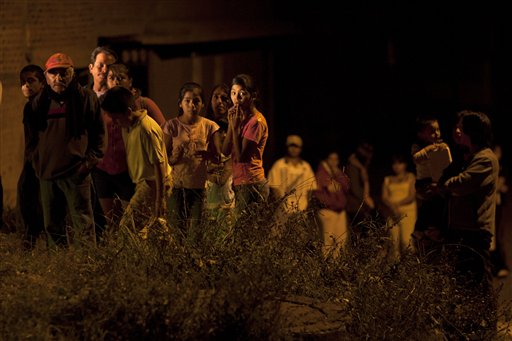By MICHAEL WEISSENSTEIN
Associated Press
MORELIA, Mexico
On a cool September evening, about a half hour after the sun set on the rose-colored Baroque cathedral of this colonial city in western Mexico, three men burst into a Coca-Cola distribution center on the edge of town.
The robbers pistol-whipped three security guards, grabbed thousands of pesos in cash and fled into a poor neighborhood of crumbling brick houses. Sirens screaming, state police arrived to find the white Nissan Sentra they believe was the getaway car being engulfed in flames.
In cities and towns across Mexico, a nearly six-year offensive against drug cartels has been accompanied by a surge in common crime: assaults and robberies that grab no headlines but make life miserable for ordinary citizens.
Some experts blame the drug war for distracting law-enforcement from pursuing common criminals. Others say drug cartels have turned to common crime as a way to fund their clashes with each other, and with troops and federal police.
Some of the first effects were felt in Morelia, the once-sleepy capital of Michoacan state, where Mexico launched its war on drugs.
The clashes in Michoacan began when local traffickers who had worked with the Gulf cartel became disenchanted with the tactics of that cartel’s brutal enforcement wing, the Zetas, and formed their own gang with the avowed intention of keeping the Zetas out. The state’s Pacific coastline and rugged, green countryside are ideal for clandestine operations such as methamphetamine labs.
A war erupted between the new group, which called itself La Familia Michoacana, and the Zetas, military defectors known for exploiting areas they control through extortion, kidnapping, drug trafficking and other crimes.
Less than two weeks after taking office in December 2006, President Felipe Calderon ordered thousands of troops to Michoacan, his home state, with orders to quash the violence.
Hundreds were killed across the state in battles between traffickers and in government actions. In September 2006, gunmen threw five severed heads onto the dance floor of a bar in the city of Uruapan, a crime so ghastly it made international news.
Meanwhile, common crime began to increase, with reported robberies rising 35 percent between 2006 and 2011 in the jurisdiction that includes Morelia, an international tourist attraction once best known for its Spanish-language schools, lush green parks and immaculately preserved 16th-century architecture. Robberies appear to be on track to rise again this year.
Nearly six years later, the military remains in Michoacan. Its operations have helped splinter La Familia into two dueling groups that themselves are fighting with at least two other cartels, including the Zetas, along the edges of Michoacan.
Soldiers and federal officers still clash almost daily with heavily armed cartel gunmen. Kidnappings are frequent, and discoveries of dismembered, beheaded bodies are a regular occurrence throughout much of the state. Homicides rose 68 percent in the state between 2006 and 2011. They rose 35 percent nationwide.
As for the street crime, state officials say they are making progress in Morelia through purges of corrupt and incompetent police officers and better management of the remaining police, and they say some crimes, including several types of robbery and assault, are decreasing. But Morelia residents say they don’t feel safer.
Joe Maria Cazares Solorzano, president of the Morelia-based state commission on human rights, said people in the region have learned to expect the unexpected.
A similar wave of common crime has hit other Mexican cities.
Nationwide, robberies increased 45 percent between 2005 and the start of 2012, with the number of bank robberies almost quadrupling, from 200 to 768.
Mexicali, on the California border, saw a 70 percent surge in robberies between 2006 and 2011, although the figures seem to be falling slightly this year. The Pacific coast resort city of Acapulco, hit by a vicious struggle among small local drug gangs, saw robberies rise by around 400 percent. The northern city of Chihuahua saw a nearly 30 percent rise.
For decades, drug cartels controlled swaths of territory largely uncontested, letting them focus on moving massive amounts of narcotics north through Mexico, striking deals with corrupt officials with the least possible disruption to both sides. With the government’s assault on the cartels, many have splintered, lost control of territory and gone to war against each other and against authorities.
Edgardo Buscaglia, a senior scholar at Columbia University who studies organized crime in Latin America, said the cartels have turned to other illegal businesses to make money.
On March 5, 10 blocks from the manicured lawns of Morelia’s idyllic central square, two armed men held up a Bancomer bank branch, shooting a woman in the shoulder and getting away with 123,000 pesos in cash, about $13,600. Over the next seven months, Morelia was hit by an average of one bank robbery a month, including two on a single day in August. In 2006, Morelia had just five bank robberies all year.
Inspector Osvaldo Torres, a state police official whose jurisdiction includes Morelia, said he believes most street crime has no connection to the drug cartels.
Torres said he has seen a drop in street crime over the last eight months, partly because officers are responding more quickly to crime now that their work shifts has been reduced from 24 to 12 hours and they are less tired on the job.
Federal statistics show the overall number of robberies outpaced population growth, rising more than 6 percent in the first eight months of this year, to 5,915 for a city with a population of more than 730,000 people.
Carlos Arrieta, a spokesman for state prosecutors, said he could not speak in detail about the causes of crimes that occurred before the current administration took office. But he attributed much of the rise to the increasing population of Morelia, which has expanded by roughly 100,000 people over the last decade.

COMMENTS
Please let us know if you're having issues with commenting.